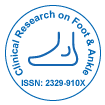当社グループは 3,000 以上の世界的なカンファレンスシリーズ 米国、ヨーロッパ、世界中で毎年イベントが開催されます。 1,000 のより科学的な学会からの支援を受けたアジア および 700 以上の オープン アクセスを発行ジャーナルには 50,000 人以上の著名人が掲載されており、科学者が編集委員として名高い
。オープンアクセスジャーナルはより多くの読者と引用を獲得
700 ジャーナル と 15,000,000 人の読者 各ジャーナルは 25,000 人以上の読者を獲得
インデックス付き
- Google スカラー
- シェルパ・ロミオ
- Jゲートを開く
- アカデミックキー
- レフシーク
- ハムダード大学
- エブスコ アリゾナ州
- OCLC-WorldCat
- パブロン
- ジュネーブ医学教育研究財団
- ユーロパブ
- ICMJE
役立つリンク
オープンアクセスジャーナル
このページをシェアする
抽象的な
Determinants from Several Systems Linked to Metatarsophalangeal Joint Deformity in People with Type 2 Diabetes
Ankeet P
In patients with diabetes mellitus (DM), can affect multiple body systems. The aim of this cross-sectional study was to identify multisystem factors associated with metatarsophalangeal joint deformity in individuals with type 2 diabetes and peripheral neuropathy (n=60). Metatarsophalangeal joint deformity was quantified using computed tomography (CT) scans. Whole-body biomarkers included musculoskeletal “intrinsic muscle deterioration of the foot, tarsal/metatarsal bone density, ankle dorsiflexion, and metatarsophalangeal extension during standing tasks.” increase. Vasculature "ankle-humeral index". and the endocrine/immune system (sensitive C-reactive protein, endogenous fluorescence and hemoglobin A1C). Muscle wasting (r=0.27), bone mineral density (r=-0.35), metatarsophalangeal extension (r=0.50), maximal dorsiflexion (r=-0.31), and ankle-humeral index (r=0.33) was related. with metatarsophalangeal joint deformity (p<0.05). Regression models related to deformation preserved bone density and metatarsophalangeal extension (R2 = 0.34). All musculoskeletal biomarkers and the ankle-humeral index showed a weak to moderate association with metatarsophalangeal joint deformity. Tarsal/metatarsal bone mineral density and toe extension during standing movements were the two strongest factors associated with metatarsophalangeal deformity. Assessment and management of bone mineral density and toe extension movement patterns in the foot may reduce the risk of metatarsophalangeal joint deformity and skin injury and subsequent amputation.

 English
English  Spanish
Spanish  Chinese
Chinese  Russian
Russian  German
German  French
French  Portuguese
Portuguese  Hindi
Hindi